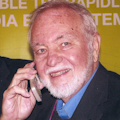I have always thought that carrying GHz signals over a copper cable just short of a miracle. With all the resistance, inductance, capacitance (RLC), and other losses you might expect the signal would dissipate to nothing over even the shortest of cables. But while cable attenuation is great, it is not a knock out factor. If you can live with a bit of attenuation, copper cables can and do carry GHz signals. This is especially true of coax cables that deliver RF signals. You can buy coax good to 40 or 65 GHz if you can live with the 2 to 6 dB/meter attenuation. You don’t necessarily want to use long runs of it but for short connections between equipment, it is not a problem. For long runs you need hard line, a large rigid coax cable made of copper and aluminum. It can be several inches in diameter but the loss at GHz frequencies is minimal even on long runs up a tower to an antenna.
Twisted pair is another whole media altogether. We already have unshielded twisted pair (UTP) that carries signals up to 500 MHz. UTP is usually carrying digital data rather than analog or RF signals. Besides of all the RLC losses there is also the issue of crosstalk between adjacent pairs. Yet over the years, techniques like equalization, pre-emphasis and de-emphasis and other signal processing techniques have made it possible to maintain signal integrity over many feet.
While most of the world is still living off of Cat 5 and Cat 5e cable, data centers have moved on to available Cat 6A and Cat 7A cables that are good for short distances, usually less than 30 meters. These are the familiar cables with four 100-ohm twisted pairs and good for up to 500 MHz. These twisted pair cables are standardized by the Telecommunications Industry Association (TIA) under its TIA-568 category. Now the TIA is working on the Cat 8 standard which is expected to be finalized by the end of the year. The 42.7 subcommittee is headed up by Sterling Vaden of the Optical Cable Corporation (OCC), a company that makes both copper and optical cabling systems for data centers.
With data center speed demands increasing almost daily, faster cabling is essential. While optical cables have been available for years, they are significantly more expensive than copper cables so data centers usually defer to copper if it will do the job. Cat 6A and Cat 7A cables have almost run their course, thus the push for a Cat 8 version.
Vaden says that it is important for data center managers and suppliers to know what Cat 8 will be like and how it may affect the data center infrastructure. Overall, Cat 8 cable will contain four shielded twisted pairs and have a diameter about the same as Cat 6a and Cat 7a cables. The bandwidth is specified to 2 GHz. RJ-45 connectors will be used. The goal of the cable is to handle the forthcoming evolution to the IEEE Ethernet standard for 40 Gb/s over copper cables. At that frequency, the maximum reach is expected to be 30 meters. I am still not fully buying that but we shall see.
You can expect Vaden’s employer OCC to offer Cat 8 cables as well as the equipment to test them. For more details contact OCC at www.occfiber.com
It is good to know that copper is not dead. I am still amazed at how companies have extended the life of copper cables with hard core research and development. But can there possibly be a Cat 9 in the future?
About the Author

Lou Frenzel Blog
Communications Technology
Click here to find more of Lou's articles on Electronic Design.